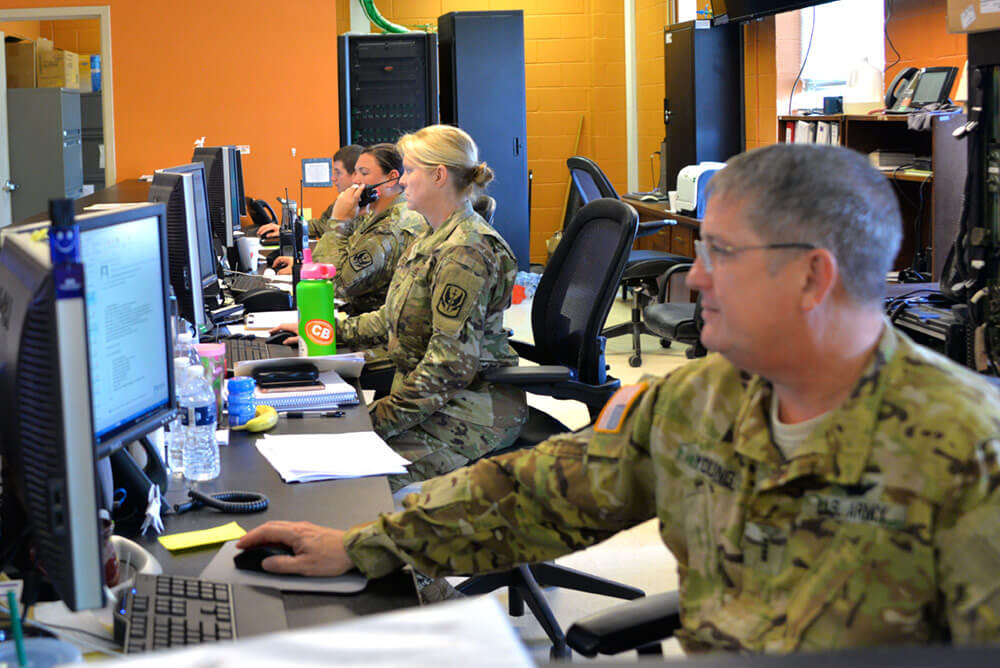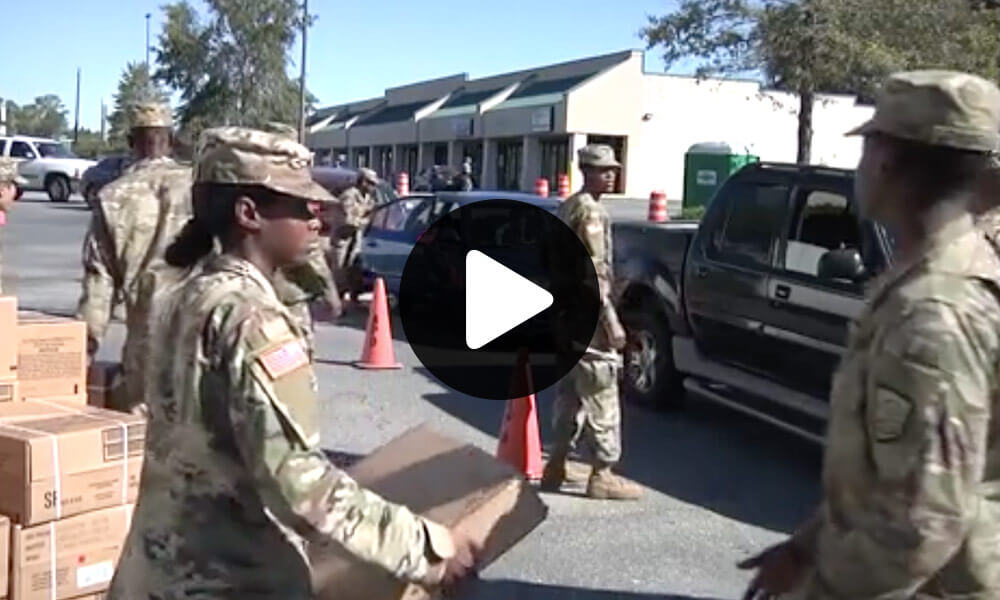When Hurricanes Florence and Michael struck the southeast coast of the United States late in the summer of 2018, Army National Guard Soldiers, civilian first responders and everyday residents banded together to offer shelter, food and aid to those most impacted by the storms’ devastation.

Hurricane Florence
Over 6,600 National Guard members, sent from at least 28 States, were sent to support the States of North and South Carolina in recovery from Hurricane Florence. That type of unity is what South Carolina’s Adjutant General MG Robert Livingston described as the most effective tool in alleviating the destruction of hurricanes. “Everything is unified,” he said.
Landfall
At a quarter after seven o’clock in the morning on Sept. 14, 2018, the eye of Hurricane Florence made landfall on the coast of North Carolina, near Wrightsville Beach. The storm lingered. It crept over the landscape at just 6 miles-per-hour (mph), but with maximum sustained winds estimated at 90 mph – making it a slow-moving, yet deadly, Category 1 Hurricane, according to the National Hurricane Center.

Thirteen States were unified in sending service members to join the more than 3,000 North Carolina National Guard members activated in response to the massive storm. Connecticut, Illinois, Indiana, Maryland, Michigan, Minnesota, Mississippi, Nebraska, New Jersey, New York, Oklahoma, Tennessee and Wisconsin National Guards sent Soldiers and Airmen to support North Carolina’s recovery effort. Air support vehicles included CH-47 Chinooks sent by five States; Black Hawk helicopters sent by 11 States; additional helicopters sent by the U.S. Coast Guard and other rotary wing aircraft sent by the North Carolina State Highway Patrol.
“I would put it right up on the scale with Hurricane Matthew. Along the coast, there was a lot of surge and wind damage. Then, once the storm stalled a little bit, the rain just heavily impacted southeastern North Carolina,” said SGM Robert Bowen, acting command sergeant major of 30th Armored Brigade Combat Team, North Carolina Army National Guard.
At the height of the relief effort, 50 aircraft were used in 346 missions, resulting in the rescue of over 440 citizens and 127 animals. National Guard members and first responders moved more than 685,000 pounds of supplies and equipment during the response.

“We switched over during the storm to what we call “all-purpose support packages.” That’s [when we] go out and do multiple different things, rather than just specializing in one area. That allows the State counties and the National Guard the flexibility to do anything from food distribution, to security, to transportation needs, to even flooded-area rescue.”
Of the missions completed by the North Carolina National Guard, most were east of Interstate 95 and included search and rescue, swift-water rescue support, sandbag operations, commodities distribution, evacuations and support to local law enforcement and first responders.
Days after the storm had passed, North Carolina’s State CSM Russell Prince assured citizens that the National Guard was still working on their behalf.
“Remember, no mission is complete until you are returned to the arms of your loved ones back home,” he said in a video posted on the North Carolina National Guard Facebook page.

As their neighbors to the north worked hard to mitigate storm damage, South Carolina was responding to its own challenges from Florence. To meet the impending danger, the South Carolina National Guard mobilized 2,200 Soldiers and Airmen in advance of the storm making landfall. “Team South Carolina,” as it was named, also included 3,000 Department of Transportation workers and hundreds of State police and public safety officers. By the time Florence reached the shores of South Carolina, 35 emergency shelters were already open and taking in residents.
During the response, South Carolina Guard Soldiers filled and delivered sandbags to several counties in the northeast region of the State to protect infrastructures in advance of flooding after Hurricane Florence downgraded to a Tropical Storm. One-ton sandbags were applied to prevent flooding in the Pee Dee Region in the northeast. Soldiers from the 218th Brigade Support Battalion worked day and night to fill, load and move more than 1,500 sandbags to Lake Busbee in Conway, South Carolina, to assist with flood prevention along federal Highway 501. In all, over 10,000 linear feet of barrier material and 126,000 sandbags were positioned within the larger Highway 501 corridor, according to an Army report.

The South Carolina Helicopter Aquatic Rescue Team (SC-HART) was a critical asset on duty in response to Hurricane Florence. SC-HART is a mixed team made up of rescuers from South Carolina’s Urban Search & Rescue Task Force 1 along with pilots and aircrew from South Carolina Army National Guard’s 2nd Battalion, 151st Aviation Unit.
“We have been able to combine State and National Guard capabilities to not only support the citizens of South Carolina, but of the [entire] Nation as well,” CW4 Tripp Hutto told fellow South Carolina Army Guard photojournalist SGT Brad Mincey. “This is why we have the HART team, to provide a capability to the State of South Carolina that didn’t [previously] exist to our citizens. We blend our aviation expertise and military assets with civilian first responder expertise and assets and we have a well-oiled, all-purpose search and rescue capability.”
MG Livingston recognized the contribution of the HART team during the Hurricane Florence response and went on to emphasize the level of integration the South Carolina National Guard has with civilian counterparts.
“If you look at our HART teams,” he said, “[There are] military aircraft, military operators and civilian swimmers. They come out to the fire departments in South Carolina. If you look at my sandbagging operations, we’ve got locals, we’ve got Guard Soldiers, we’ve got contractors. That partnership comes from years of rehearsal, years of planning, and unfortunately for us, years of actually going through these disasters.”
Hurricane Michael
Different from Hurricane Florence, Hurricane Michael came fast and furiously into the Florida Panhandle as a Category 4 storm. It did not linger, but moved quickly, ravaging the land over which it passed. Hurricane Michael made landfall between St. Vincent Island and Panama City, Florida, early in the afternoon of Oct. 10, 2018. With winds reaching 155 mph – just 2 mph shy of a Category 5 hurricane, the highest possible hurricane classification – Hurricane Michael was the strongest hurricane to come ashore along the Florida Panhandle going back over 150 years.

Landfall
Over 3,700 Soldiers and Airmen were mobilized in response to Hurricane Michael – with over 1,000 being mobilized prior to landfall. Service members included 148 personnel from eight States – Alabama, Arkansas, Kansas, Louisiana, Minnesota, Mississippi, New York and Ohio.
All combined, the out-of-State units brought five Chinook choppers, six Black Hawk choppers and 36 tactical vehicles for use in the response effort. Operations included search-and-rescue, boat teams, transportation, logistical support and aviation support.
Florida National Guard’s Dual Status Commander BG Rafael Ribas spoke about his directive to Soldiers to keep the essentials properly prioritized as they approached the disaster response.
“Number one with everything we do, of course, is safety,” he said. “As [Soldiers] began search and rescue, the next [priority] was to assist our citizens. Subsequent [to that] was establishing points of distribution and the security element. Finally, [our priority] was to remain in constant contact with the local leadership. That is so important because it ensures unity of effort.”
That unified effort included support from active duty units working in conjunction with the Federal Emergency Management Agency (FEMA). Before the hurricane made landfall, 2,216 active-duty personnel – responding with 32 helicopters, 240 high-water vehicles and 32 swift-water boats – were in position, ready to begin mitigation tactics.

“We are surrounding the storm,” said Gen Terrence J. O’Shaughnessy, commander of North American Aerospace Defense Command and U.S. Northern Command. “This is no small feat given the unprecedented size and strength of [Hurricane] Michael.”
The storm soon entered the State of Georgia. Nine hundred Georgia National Guard Soldiers and Airmen from 38 separate units participated in the relief effort. While early on, Mitchell and Seminole Counties in the southwest region of the State were some of the hardest hit by the storm, Baker County, Calhoun County, Decatur County, Dougherty County, Miller County, Lee County and Terrell County were also impacted by the hurricane.
“We ran PODs [points of distribution] for the Georgia Emergency Management Agency and FEMA” said LTC John Low, deputy commander for the 648th Maneuver Enhancement Brigade. “We ran nine across southwest Georgia. We also took trailers from metro Atlanta with FEMA supplies and ran those down to the PODs. We had a transportation company doing that. And then our engineer battalion did a lot of route clearance.”

Units also used High Mobility Multipurpose Wheeled Vehicles as “mobile PODs,” delivering supplies to rural areas where farmers were trapped by downed trees and smashed farm vehicles.
In addition to running PODs, Georgia National Guard members conducted route clearance, traffic control and movement operations to and from locations in southwestern Georgia where most of the damage in the State occurred.
“We had more than enough Soldiers answer the call. In the end that was a good news story, that we had more than enough people to do what we needed to do,” remarked LTC Low. “We got down into the affected areas really before any other assets could be down there. I think it was a Guard success story – helping the civil authorities help the citizens in their time of need. And then as they got on their feet, we were able to roll back and head back home. So I think it’s a good success story for the Guard.”
by Staff Writer Matthew Liptak








